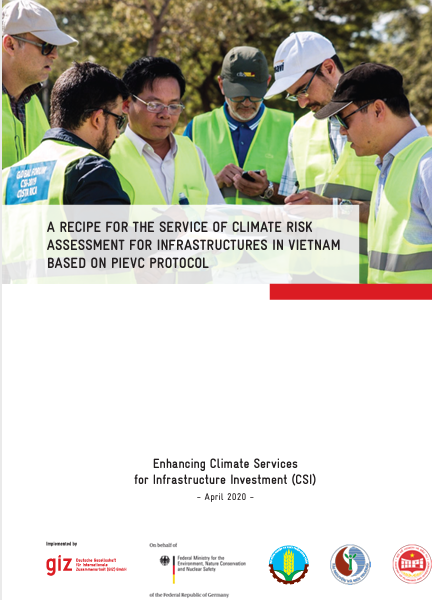Article /
A Recipe for the Service of Climate Risk Assessment for Infrastructures in Vietnam based on PIEVC Protocol

Executive Summary
This resource was submitted by the Climate Risk Institute for use by the CanAdapt Climate Change Adaptation Community of Practice.
This article is an abridged version of the original text, which can be downloaded from the right-hand column. Please access the original text for more detail, research purposes, full references, or to quote text.
Enhancing Climate Services for Infrastructure Investment (CSI)” is a global project to promote the use of climate services in planning infrastructure investments, supported by BMU of Germany and implemented by GIZ. This aims to good investment decisions with the minimum economic damage in the face of emerging climate change.
In Vietnam, the CSI has applied the climate risk assessment to the pilot case for Cai Lon – Cai Be Sluice Gates in the Mekong Delta (MKD) and obtained achievements in terms of providing the recommendations on the detail design stage. For facilitating the extension and replica of climate risk assessments in Vietnam, this assignment was to establish a recipe of a typical climate risk assessment service with detail description on the resource inputs and the involved costs required to conduct climate risk assessments.
The recipe was developed based on the successful case of climate risk assessment (CRA) for Cai Lon – Cai Be sluice gate project which was jointly completed by experts from the Southern Regional Hydro-meteorological Centre (Southern HydroMet) (under MONRE), Southern Institute for Water Resources Planning (SIWRP) and Water Resources Investment and Construction Board 10 (PMU-10) (under MARD). To address this, a detailed review on this case was conducted to the extent of the PIEVC Protocol, the personnel of the assessment team, workload of experts, timeline, documentation of Cai Lon – Cai Be sluice gate project, climate and hydrological data, workshops, consulting meetings, and field trips. The related cost norms and regulations of service provision in Vietnam were also stock taken for specifying the required resource needed for a typical climate risk assessment service.
The recipe consists of three main components, including procedure, quantity, and price.
- Procedure covers the main activities of a climate risk assessment on infrastructures as shown in the flowchart in Figure 0-1 (More information under 4.1). Firstly, all the necessary data for climate risk assessment will be collected through Activity 1 (Data purchase) and Activity 2 (Data collection and synthesis). In most cases, it is necessary to have some field trips (Activity 11) for the data collection. T hese data will be then analysed for historical trends and future forecasts, as well as evaluate their sufficiency for the climate risk assessment (Activity 3). Next, risk assessment matrices will be developed (Activity 4) during the risk assessment before considering whether to conduct an engineering analysis or not (Activity 5). It is noted that Activity 5 is optional and implemented only if an engineering analysis is required. The risk assessment matrices and the outcomes of engineering analysis (if any) will be used to propose the conclusions and recommendations for the end-users such as the infrastructure owners (Activity 6). In the next activity, a report on climate risk assessment will be accomplished for the review from the independent experts (Activity 8) before the revised final report is submitted (Activity 9). Furthermore, a number of workshops and consulting meetings will also be set up during the assessment, including a kickoff workshop, risk assessment workshops, and a dissemination workshop.
- Quantity clarifies a list of tasks and the corresponding workload (man-days) for the experts of the assessment team in different planning stages of infrastructures. This component also determines the quantity of climate and hydrological data, such as the minimum length of data, method of data collection (free or purchased), and data sources. Furthermore, the number of workshops and field trips (if any) are identified in the quantity component.
- Price identifies unit prices in terms of consultancy, data purchase, workshops, and field trips. The price component also covers a cost estimation to complete a climate risk assessment for different scenarios, including: (1) public sector is commissioning the assessment; (2) private sector is commissioning the assessment; and (3) other potential scenarios that may affect pricing (e.g. GIZ).
Suggested Citation:
Dung, D. D., Duc Cong Hiep, N., & Van Manh, P. (2020).A RECIPE FOR THE SERVICE OF CLIMATE RISK ASSESSMENT FOR INFRASTRUCTURES IN VIETNAM BASED ON PIEVC PROTOCOL Enhancing Climate Services for Infrastructure Investment (CSI). Deutsche Gesellschaft für and Internationale Zusammenarbeit (GIZ).https://climate-resilient-infrastructure.com/wp-content/uploads/2020_GIZ_CSI_VN_Recipe_EN.pdf
